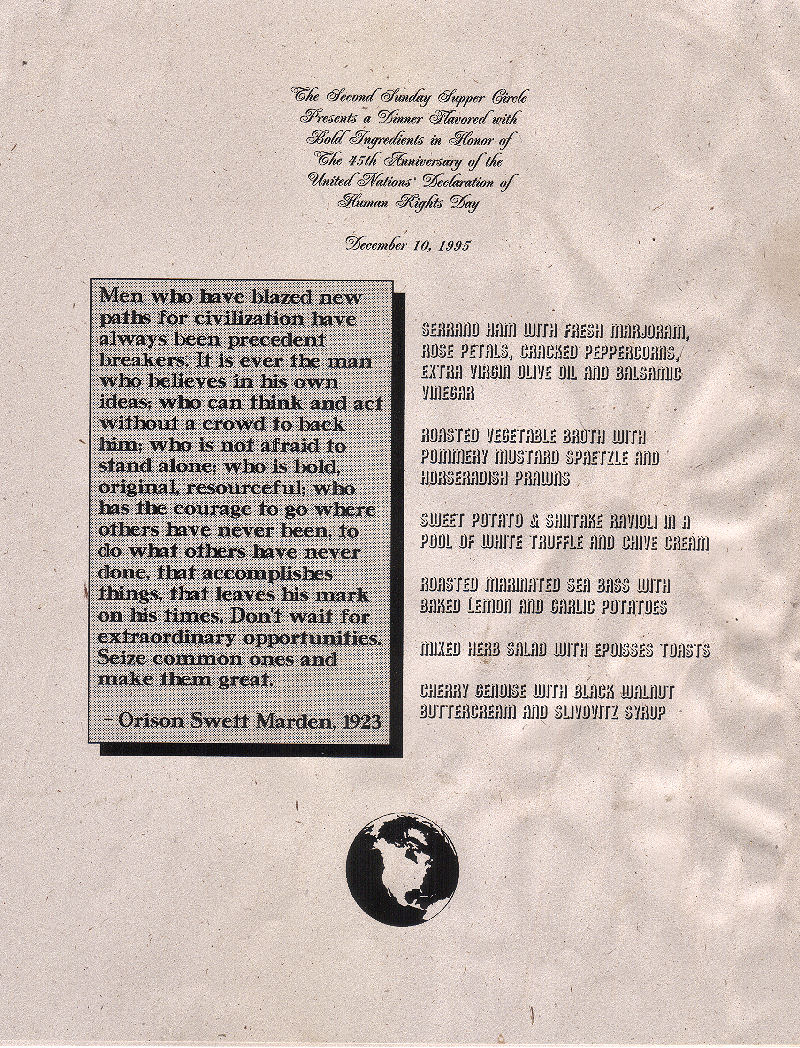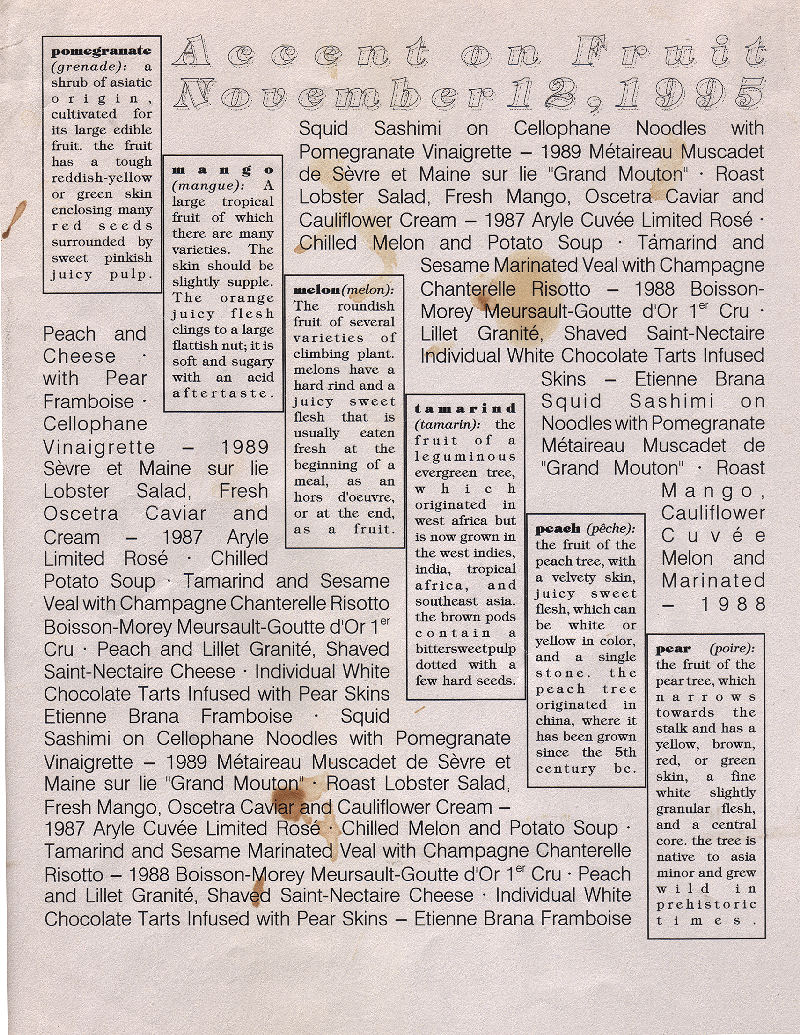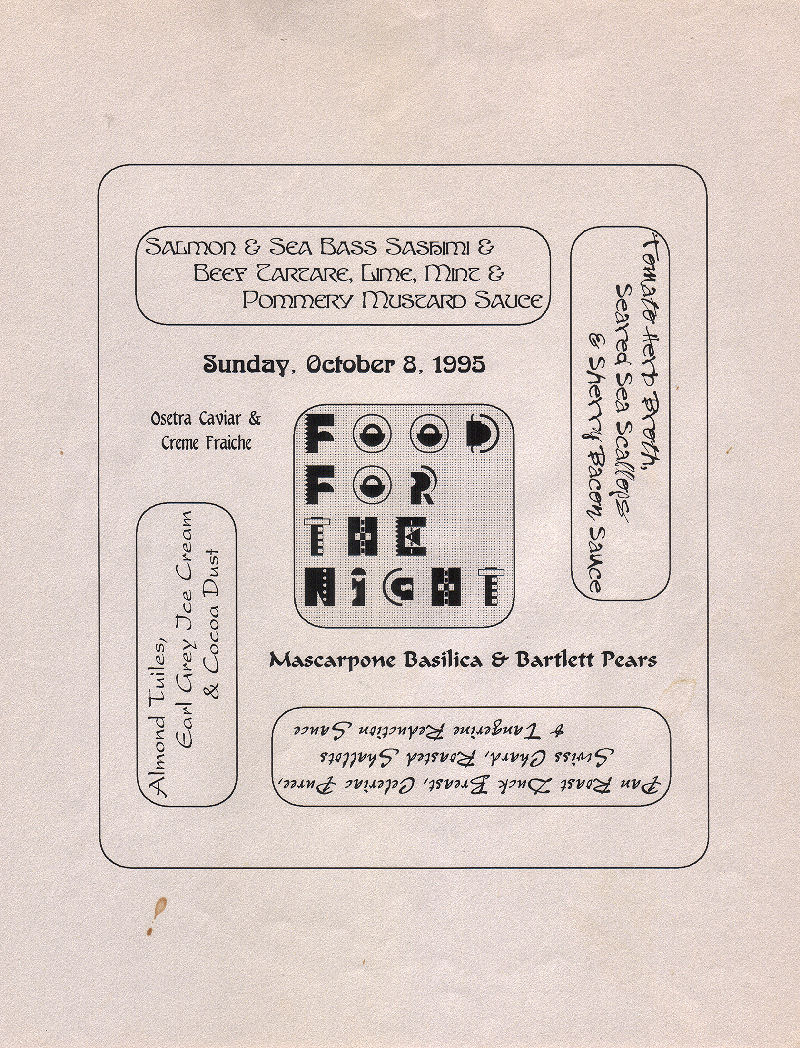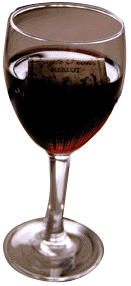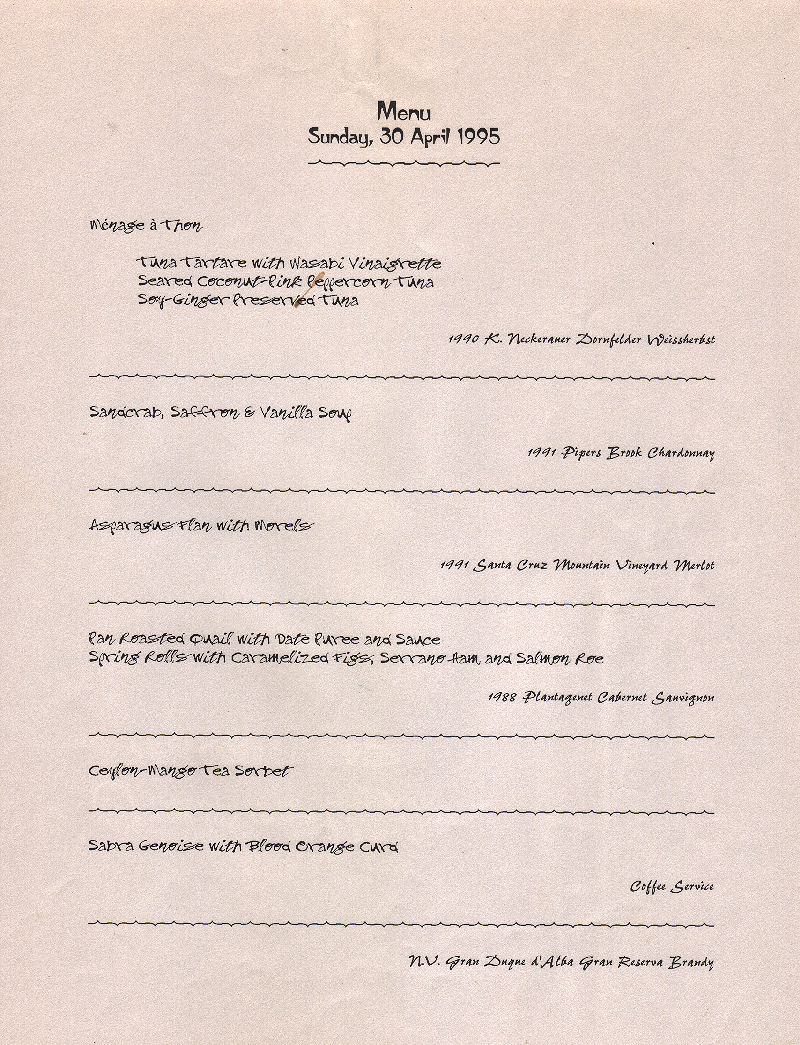Q San Francisco
Winter 1996
Pages 38-39
Pretty in Pink
The world would be a better place if we had more pink. Ask the Pink Panther. I remember a study done back in the 70s that demonstrated how different colors caused mood changes in psychotic patients. Pink created calm. Lavender may be the official color of the gay movement, but pink is almost always associated with us first.
Pink is a color for celebration, for festivities, for wine. Yes, wine. I realize that pink and wine together tend to conjure up images of semi-sweet, sometimes fizzy wines like white Zinfandel. Those of you who read my column in last issue will remember that I lumped white Zinfandel, screw- top bottle caps and plastic bendy straws into a small package suitable for a vinyl backpack. But let’s face it, there’s also red and white wine in gallon jugs that you wouldn’t want to drink.
Picture this: a toast – champagne glasses filled to the brim with frothy pink champagne. Tall, cool, crisp glasses of rosé freshing your palate as you dive into your appetizer course. Rich, full flavors of berries and spice as you move to your entrees. Soft, round tones of fruit and chocolate as you savor a flute of yet another, just barely pink champagne with your dessert. That’s a dinner I’d go to. That’s a dinner I think I’ll plan right now. So how does wine get to be pink? I mean, anyone knows that white grapes make white wine and red grapes make red wine, right? Right and wrong. Red wine pretty much has to have red grapes in it – unless you’re using large quantities of Red No. 5 dye. But it often has white grapes too. And white wine can be made from either.. Why? Because the juice of both is white, all the color is in the skin. And this leads us to rosés…
There are three basic ways to make pink wine. The first, and most obvious, is to mix red and white together. This is sometimes done with really cheap wines, but the truly classic place it is done is in Champagne. Actually, it’s the only place in the European Community you can legally make pink wine that way. The second way is to take red grapes and squeeze them really, really hard. Kind of like thighmaster exercises. Then you get just a little bit of color from the grape skins and have what is called a “vin gris.” Or, you can start making a red wine but then strain out the skins before the color of the wine gets too dark. Decisions, decisions.
Enough of the dull, technical stuff, let’s drink some wine. Here are some of my favorites in pink:
Pink Picks for Partying
In the Champagne category, my top honors go to three wineries off there in the north of France. First place, a pink ribbon, to Perrier-Jouet Fleur de Champagne Rosé. This wine blew me away the first time I tried it. Full, rich fruit flavors, dry as a bone, and an elegance that made Princess Grace look cheap. Unfortunately, the wine isn’t. But it is in a gorgeous bottle: clear glass painted all over with adorable pink flowers.. You can’t make a better impression.
Second place, coming in at a significantly lower cut of your cash, goes to Laurent-Perrier Rosé Brut. First, again, a stunning bottle. This wine comes packaged in an old 1800s style wide bottle that catches your eye. The wine itself is pale and delicate, and is perfect for reminding you that there are, indeed, finer things in life. In a close third place is Champagne de Venoge Crémant Rosé. A crémant is a champagne that isn’t quite as bubbly as usual. Rather than froth and bubbles, you get a sort of sparkling creaminess. This particular wine, again in a great bottle (see, even the bottles are great for celebrations!), is the perfect accompaniment to a lobster, especially in the form of a lobster bisque. I don’t know why, but I know it works.
Staying in the sparkling category, there are wines from places other than Champagne.that deserve special mention. First,. Maison Deutz Blanc de Noirs. Now, technically, “blanc de noirs” ought to mean white from black (the wine aficionado’s term for red grapes). But most of them are of that sort of vin gris variety we talked about, so they have a light, golden pink kind of color. This one shows that classic champagne elegance, not surprising given its connection to Champagne Deutz over in France. Beautiful berry flavors with soft toasty notes make this one the California winner.
In the truly rosé category, I’m tempted to give an award to Domaine Chandon for its Bin 222 Rosé, but again, the faintly pink Blanc de Noirs is their true winner and takes the second place spot. Rich, almost chocolatey flavors, mixed with berry fruit, make this a perfect wine to complement desserts.
And a surprising entry from the east coast of our fair nation, Pindar Cuvée Rare from Long Island is a pale salmon color, with an exuberant style that can kick off a party or wind up its finish with a bang. And the bottle’s pretty darn good-looking too.
Getting away from the bubbly, I want to recommend a few enjoyable table wines. Topping the list is Bruno Clair Marsannay Rose. Marsannay is a small commune in Burgundy. Imagine a classy Pinot Noir done in pink and you have some idea of this wine. One of the best matches with salmon I’ve ever had.
From the far southern end of the French domain comes the Domaine Ott Chateau de Selle Rosé. This wine is crisp, light, and perfect chilled as you sit outside enjoying the sunset or dig into a huge bowl of bouillabaisse, the classic fish stew of Provence, where this wine is from.
From nearby Italy, two top entries make my list. Amadea Rosato (the Italian term for rosé) gets the nod here. This is a light, slightly sparkling (frizzante in Italian) version of the Piedmontese wine Barbera. A toughy to find, but a great match for things barbecued or spicy foods. Not only that, but it’s got a handwritten label and is Kosher to boot. A very close second place goes to Regaleali Conte Tasca d’Almerita Rosato. This wine impresses me year after year. You taste it and all you can think is fun. If you can imagine strawberries, watermelon, limes and spices all rolled up in a party-pak, you’re on the right track.
I have to admit, most American winemakers went the sweet, fizzy route to pink. But slowly, some of them are realizing that good, dry table wines can be made here. One of the first, and still, in my estimation, leading the pack, was Randall Graham of Bonny Doon Vineyard with his Vin Gris de Cigare. Using primarily grape varieties native to the Rhòne valley, he has carved out a niche for an American style not seen before. This vin gris is rich in dark berry flavors, floral notes, and a smokiness that is particularly appealing. In second place, but awfully close, is Etude Pinot Noir Rosé. Coming out of the Carneros area overlapping the Napa and Sonoma valleys, this wine ties up bright berry flavors, spices and just a touch of sparkle with alight pink bow.
For a good time, think pink, drink pink. See you next time.
Dan Perlman is a chef and sommelier. He is co-owner of both Somewhere Else Catering, Inc. and Wine Partners, located in New York.
Q San Francisco magazine premiered in late 1995 as a ultra-slick, ultra-hip gay lifestyle magazine targeted primarily for the San Francisco community. It was launched by my friends Don Tuthill and Robert Adams, respectively the publisher and editor-in-chief, who had owned and run Genre magazine for several years prior. They asked me to come along as the food and wine geek, umm, editor, for this venture as well. In order to devote their time to Passport magazine, their newest venture, they ceased publication of QSF in early 2003.





